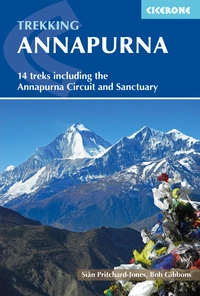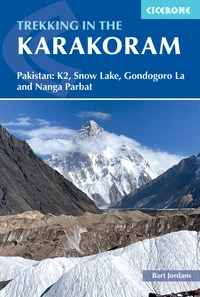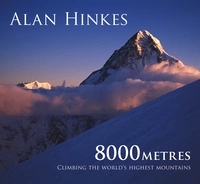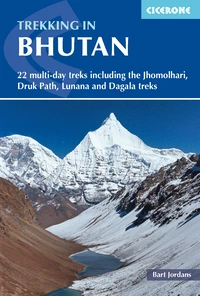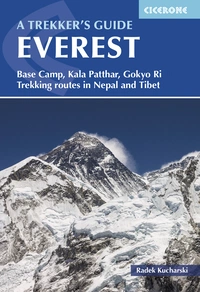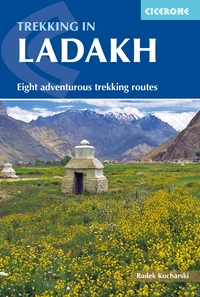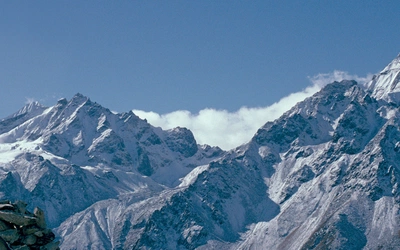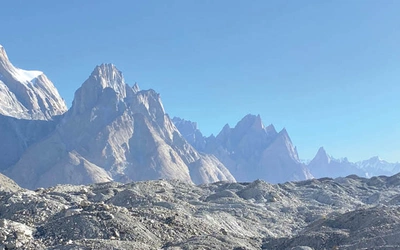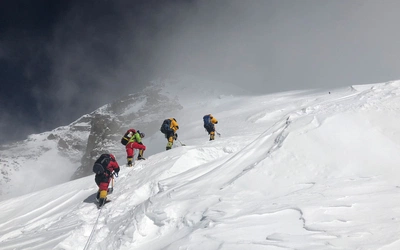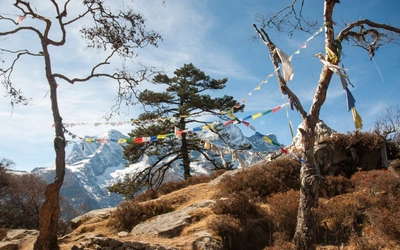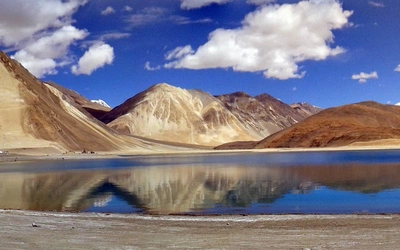Trekking the Annapurna: everything you need to know
The Annapurna region, a jewel of the Himalayas, offers one of the most captivating trekking experiences on Earth. Unlike a solitary peak, the Annapurnas form a sprawling massif — a dramatic collection of jagged summits, glaciated valleys, and high passes that stretch over 60km across central Nepal. The landscapes here shift from subtropical forests and terraced farmlands to alpine meadows and desolate high-altitude deserts. Whether you're a seasoned hiker or a first-time adventurer, here is everything you need to know to plan your trip to the Annapurna region.
Annapurna
14 treks including the Annapurna Circuit and Sanctuary
£18.95
A comprehensive trekking guidebook to the Annapurna region - the most popular trekking area in Nepal. Fourteen diverse treks are described including the classic Annapurna Circuit and the Annapurna Sanctuary as well as treks in the lesser known Machhapuchhre area, the foothills of Lamjung Himal and restricted areas - Mustang, Damodar and Nar-Phu.
More informationEssential facts:
What is it? A vast Himalayan massif with multiple trekking routes and iconic peaks.
Where is it? Central Nepal, north of Pokhara, in the Annapurna Conservation Area.
Total distance? Depends on the route — the full Annapurna Circuit is around 230km.
Cumulative ascent? Roughly 10,000 metres for the full circuit.
Time to complete? Anywhere from 7 to 21 days, depending on route and pace.
Why trek here? For world-class mountain scenery, cultural depth, and route variety.
Why trek in the Annapurna region?
Few trekking regions offer such a remarkable contrast in geography, climate, and culture within a relatively compact area. Within days, you’ll pass through rhododendron forests, high-altitude deserts, and alpine valleys dotted with yak herders and Buddhist chortens.
Each trail leads through traditional villages — home to the Gurung, Magar, Thakali, and other ethnic groups — where everyday life is lived out against a backdrop of towering peaks like Annapurna I (8,091m), Machapuchare (6,993m), and Dhaulagiri (8,167m).
Whether you're a seasoned hiker or a relative newcomer, the region offers something uniquely rewarding. From spiritual reflection in the Annapurna Sanctuary to high-altitude thrills on the Thorong La Pass, Annapurna treks are journeys of both physical and emotional significance.
When is the best time to visit?
- Autumn (October–November): Peak trekking season. Expect crystal-clear skies, dry trails, and panoramic views.
- Spring (March–May): Lush landscapes, flowering rhododendrons, and comfortable temperatures.
- Winter (December–February): Quiet trails and snowy scenery — great for solitude but cold and challenging at altitude.
- Monsoon (June–September): Heavy rain, landslides, and poor visibility make trekking difficult. Best avoided unless visiting rain-shadow regions like Upper Mustang.
How difficult are the Annapurna treks?
The difficulty depends on your chosen route. While some trails are beginner-friendly, others demand a high level of fitness and altitude awareness.
- Moderate: Ghorepani Circuit, Mardi Himal.
- Challenging: Annapurna Sanctuary, Annapurna Circuit.
- Strenuous: Nar–Phu Valley and side treks involving high passes.
Treks often involve long days of hiking, steep ascents and descents, and exposure to high altitudes. Acclimatisation days and a steady pace are crucial.
How long are the Annapurna Treks?
Choose a route to match your timeframe and ambition:
- Annapurna Circuit: 15–21 days — a full loop around the massif via Thorong La Pass.
- Annapurna Sanctuary (ABC): 7–12 days — straight into the mountain amphitheatre.
- Ghorepani Circuit / Poon Hill: 4–6 days — short and scenic, with stunning sunrise views.
- Nar–Phu Valley: 10–14 days — remote, rugged, and culturally rich.
- Mardi Himal: 5–7 days — less crowded, with sharp ridgelines and Machapuchare views.
Are the routes well-marked?
Yes, especially on the more popular trails. The Annapurna Circuit and Sanctuary routes are clearly marked and well-trodden. However, for remote treks like Nar–Phu or side excursions to Tilicho Lake, it’s best to bring a detailed map, GPS device, or trek with a guide.
What should you pack?
Packing well can make or break your trek. Here’s what to bring:
- Footwear: Broken-in, waterproof hiking boots with good ankle support.
- Clothing: Layered gear including base layers, fleece, down jacket, waterproof outer shell, gloves, and thermal hat.
- Trekking Gear: Daypack, trekking poles, water bottles, head torch, and sleeping bag (tea houses sometimes lack adequate bedding).
- Health & Safety: First-aid kit, blister care, water purification tablets or filter, high-SPF sunscreen.
- Other Essentials: Sunglasses, hat, snacks, lightweight towel, and a power bank.
- Optional extras: reading material, journal, camera, gaiters, and a lightweight dry bag.
Are luggage transfers available?
Yes. Many trekkers hire porters or mule services to carry main packs, leaving you free to walk with a lighter daypack. Porters are an important part of the local economy, but always hire through reputable agencies that support fair treatment and weight limits (typically around 15kg per porter).
What accommodation is available?
- Tea Houses: The standard for Annapurna trekking. Basic but atmospheric, with communal dining areas and simple meals.
- Homestays: Available in some villages, offering deeper cultural immersion and warm hospitality.
- Camping: Required on remote routes like Nar–Phu or Tilicho Lake, or if you want to go fully off-grid.
- Luxury Lodges: Found on parts of the Sanctuary and Ghorepani routes — private rooms, hot showers, and gourmet meals.
How do you get there?
- By Air: Fly from Kathmandu to Pokhara (approx. 30 minutes).
- By Road: Tourist buses and private vehicles connect Kathmandu and Pokhara (6–9 hours depending on traffic and road conditions).
- Trek Starting Points:
- Besisahar for the Annapurna Circuit.
- Nayapul for the Ghorepani Circuit and Annapurna Sanctuary.
- Kande or Dhampus for Mardi Himal.
- Koto for Nar–Phu (reached via Besisahar–Chame road).
Should you trek the Annapurna circuit clockwise or anti-clockwise?
For the Annapurna Circuit, the anti-clockwise route is strongly recommended. It allows for gradual acclimatisation before crossing the Thorong La Pass and makes the steepest sections more manageable.
Clockwise trekkers face rapid altitude gain and steeper ascents — not ideal for most people, though some experienced trekkers prefer it for the solitude.
Top tips for first-time trekkers:
- Train beforehand: Focus on cardiovascular fitness, leg strength, and endurance.
- Acclimatise properly: Stick to the golden rule — “climb high, sleep low.”
- Hydrate and eat well: Proper nutrition and hydration aid altitude adjustment.
- Start early: Mornings offer the best weather and views.
- Pack smart: Bring essentials, leave luxuries behind.
- Respect culture: Learn a few Nepali phrases and follow local customs. Modest dress is appreciated in villages and religious sites.
What are the cultural highlights?
As you trek through the Annapurna region, you’ll encounter a rich tapestry of cultures, where Hindu, Buddhist, and animist traditions exist side by side. One of the most memorable experiences is visiting ancient Buddhist monasteries, such as those in Braga, Pisang, and Nar, where prayer flags flutter in the wind and monks offer quiet blessings. In Muktinath, a sacred site revered by both Hindus and Buddhists, you can light a butter lamp and witness pilgrims bathing beneath the 108 holy water spouts. Along the way, you’ll have the chance to sample Thakali cuisine — a regional speciality known for its balanced flavours and variety of pickles and spices. Depending on the time of year, you may also come across village festivals that celebrate the agricultural calendar, religious milestones, or seasonal changes. Spending time in traditional homes and farms gives a unique insight into the daily rhythms of mountain life and the warm hospitality that defines the Annapurna experience.
Annapurna
14 treks including the Annapurna Circuit and Sanctuary
£18.95
A comprehensive trekking guidebook to the Annapurna region - the most popular trekking area in Nepal. Fourteen diverse treks are described including the classic Annapurna Circuit and the Annapurna Sanctuary as well as treks in the lesser known Machhapuchhre area, the foothills of Lamjung Himal and restricted areas - Mustang, Damodar and Nar-Phu.
More information
